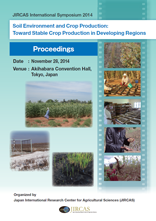Genetic Improvement of Salt Tolerance in Soybean

About 7% of the earth’s land and 20% of the irrigated land is affected by salt stress. Salt-affected
soils are generally classified into two main categories: saline and sodic (alkaline). Soybean (Glycine
max (L.) Merr) is generally regarded as a salt sensitive crop compared with other crops such as wheat,
rice, and cotton. Genetic improvement of salt tolerance is essential for maintaining sustainable
production in areas where soybean growth is threatened by salt stresses. A series of studies consistently
revealed a major quantitative trait locus (QTL) for saline tolerance located on chromosome 3 around
the SSR markers Satt255 and Sat_091; other minor QTLs were also reported (1, 2, 3, 4). Map-based
cloning and whole-genome-sequecing approches were employed for identification of the gene
coffering saline tolerance at this locus. Field experiment results showed that the saline tolerance gene
could greatly increasee soybean grain yield in a salinity field condition. Isolation and characterization
of the saline tolerance gene might contribute to the sustainable of soybean production in saline area by
introducing it into the local soybean varieties by either DNA marker-assisted slection or gene
transformation methods. In the case of sodic tolerance, previous studies mainlu focused on iron
deficiency caused by a high soil pH, and several QTLs associated with iron deficiency were identified
(5, 6). A wild soybean (Glycine soja Sieb. & Zucc.) accession with high sodic tolerance was recently
identified, and a significant QTL for sodic tolerance was detected on chromosome 17 (7, 8). These
studies demonstrated that saline and sodic tolerances were controlled by different genes in soybean.
DNA markers closely associated with these QTLs can be used for marker-assisted selection to pyramid
tolerance genes in soybean for both saline and sodic stresses.
| Date of issued | |
|---|---|
| Creator | Donghe Xu |
| Subject |
Glycine max Glycine soja saline sodic tolerance genetic improvement |
| Publisher | Japan International Research Center for Agricultural Sciences |
| Available Online | |
| Issue | 2014 |
| spage | 141 |
| epage | 149 |
| Rights | Japan International Research Center for Agricultural Sciences |
| Language | eng |
